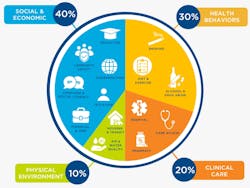© Alexander Raths | Dreamstime
Helping employees keep healthy is a multi-faceted effort. And understanding the variety of factors that are involved can assist employers in devising solutions to address them.
One aspect to consider is that the majority, 80%, of health outcomes are determined by employee behaviors and the social and environmental conditions in which they live and work, according to a recent article by Cigna.
These social determinants of health (SDOH) can become obstacles to achieving and maintaining good health. And one of the results of this, according to recent Cigna claims data, is that people who experience negative impacts of SDOH are:
- 1.9X more likely to have an avoidable emergency room (ER) visit
- 1.6X more likely to have an avoidable inpatient visit
To help employers mitigate these issues, they recommend the following:
Encourage healthy employee behaviors
- Set up fitness classes or well-being activities (onsite or virtual) that allow participation on company time or offer employee reimbursement for local gym memberships.
- Offer healthy food alternatives in vending machines and at office meetings. Onsite cafeterias and healthy food trucks can help facilitate access to nutritious, affordable meals to address food insecurity. For remote workers, consider subsidizing community-supported agriculture (CSA) and meal-kit delivery subscriptions.
- Offer smoking cessation programs and treatment for substance use disorders as part of your health benefits, and enable a medical leave policy to support employee participation.
Support social and economic needs among your workforce (including isolation, education, and financial issues)
- Arrange team-building events and social gatherings to foster connections among your employees. Taking part in local volunteer programs can help build community engagement.
- Set up career training or tuition reimbursement programs with local colleges and training centers. Online training classes are especially convenient for those with limited transportation.
- Provide financial counseling opportunities with a local financial advisor. Many employee assistance programs (EAPs) include such services at a discount, and these programs may also arrange financial planning seminars and lunch-and-learns for your employees.
- Connect employees to local community resources and social services via an EAP or FindHelp.org.
Address workforce challenges in your community (e.g., housing and transportation insecurity)
- Consider an employer-assisted housing program, if possible. Provide employees with legal assistance and/or an advocate on their behalf when bad housing conditions or property management problems arise.
- Allow flexibility for fully remote or hybrid working arrangements to address workers' transportation issues. Establish a ridesharing/carpooling program or offer subsidies for mass transit to enable lower-income employees to get to work or medical and social services appointments.
- Partner with your health plan and local care systems and advocacy groups to see how you can support SDOH efforts in the areas where your employees live.
Continue to enable employee access to clinical care
- Maintain continuous education on the health care benefit so employees are aware of available health benefit options, are able to determine the type of plan and level of coverage that will best serve them and their families, and understand how to access services and resources.
- Offer mental health coverage. Enabling employees to maintain good mental health is vital for their overall health, and can help them better cope with everyday stress and work more productively.
- Set up workplace access to health care services for preventive care screenings and minor care needs (such as an onsite clinic, a health coach on staff, or mobile dentistry and mammography services). If this is not feasible, offering adequate sick leave and flex time options can enable employees to attend to their needs.
Voice your opinion!
Voice your opinion!

